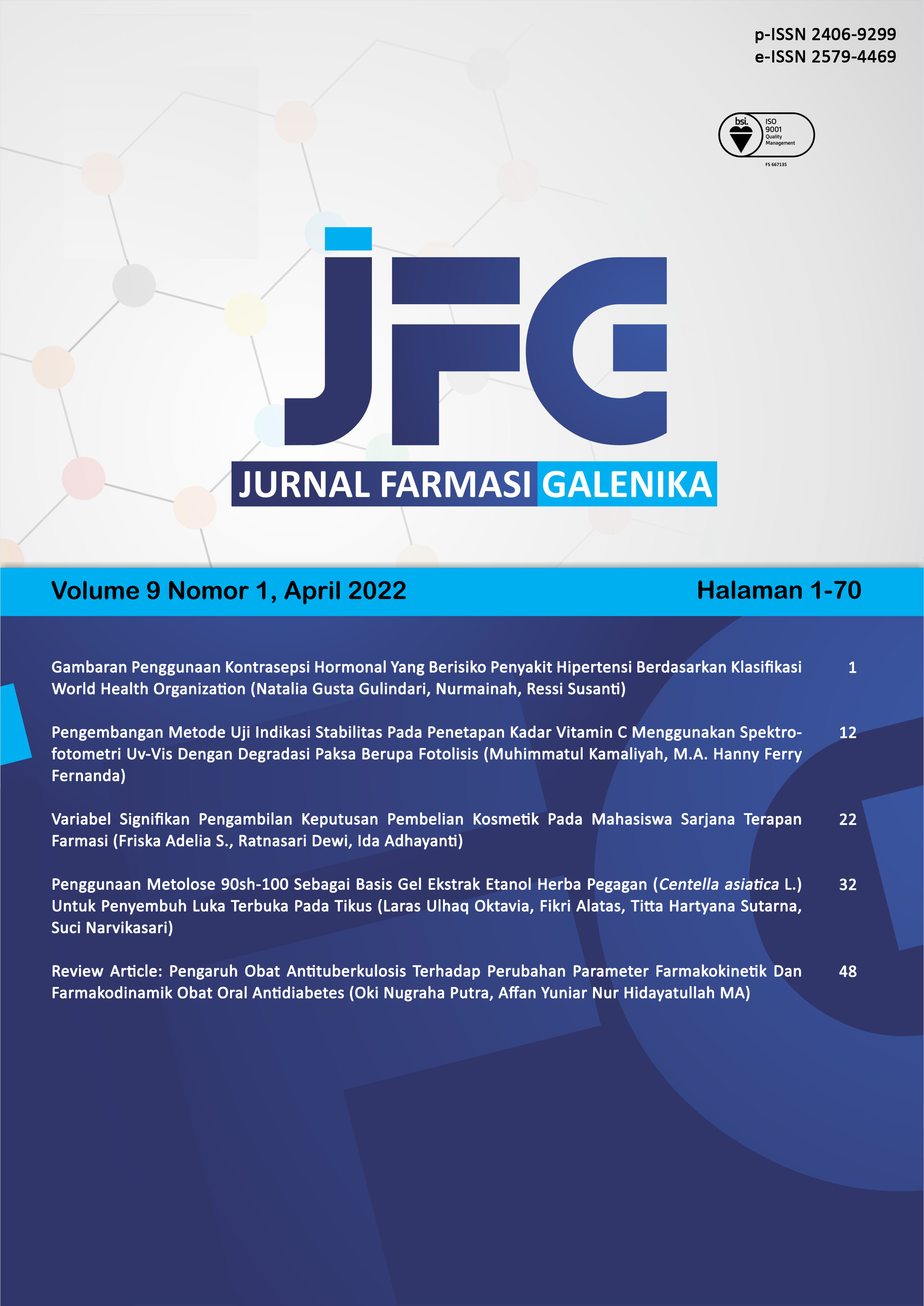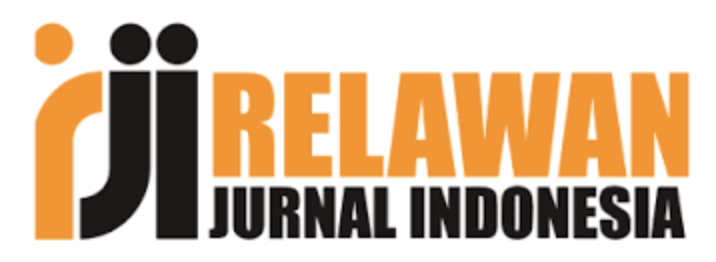Penggunaan Metolose 90-SH100 Sebagai Basis Gel Ekstrak Etanol Herba Pegagan (Centella Asiatica L.) Untuk Penyembuh Luka Terbuka pada Tikus
DOI:
https://doi.org/10.70410/jfg.v9i1.212Keywords:
Centella asiatica L., Metolose 90SH-100, luka, gel, tikusAbstract
Turunan selulosa banyak digunakan sebagai basis gel karena biokompatibilitasnya, viskositasnya yang bervariasi, dan kemampuannya dalam menyerap eksudat luka. Metolose 90SH-100 adalah salah satu turunan selulosa yang memiliki viskositas 100.000 cPs. Penelitian ini bertujuan memformulasi sediaan gel ekstrak ektanol herba pegagan (Centella asiatica L.) dengan menggunakan basis Metolose 90SH-100, menguji stabilitas fisik dan mengetahui efektivitasnya sebagai penyembuh luka terbuka pada tikus. Ekstrak etanol herba pegagan disiapkan dengan teknik maserasi. Formula gel ekstrak pegagan 5% dibuat dengan variasi konsentrasi Metolose 90SH-100 berturut-turut 4% (F1), 5% (F2), dan 6% (F3). Evaluasi fisiki meliputi organoleptik, pH, viskositas, dan daya sebar. Formula terbaik diuji stabilitas fisiknya selama 28 hari dan efektivitasnya sebagai penyembuh luka terbuka pada tikus. Gel ekstrak etanol herba pegagan 5% dengan konsentrasi Metolose 90SH-100 4% (F1) memiliki sifat fisik terbaik. Viskositas, pH dan daya sebar F1 stabil selama 28 hari penyimpanan pada suhu ruang dalam kondisi wadah tertutup. Hasil pengujian efektivitas penyembuh luka terbuka pada tikus menunjukkan kelompok uji (gel ekstrak etanol pegagan 5%) memiliki kecepatan penyembuhan luka terbuka lebih cepat daripada kelompok kontrol (basis gel) (P<0,05). Kecepatan penyembuhan luka kelompok uji setara dengan kelompok pembanding (povidone-iodine 10%) (P≥0,05).
Downloads
References
Csóka, G., Gelencsér, A., Makó, A., Marton, S., Zelkó, R., Klebovich, I., & Antal, I. (2007). Potential application of Metolose® in a thermoresponsive transdermal therapeutic system. International Journal of Pharmaceutics, 338(1–2), 15–20. https://doi.org/10.1016/j.ijpharm.2007.01.018
Demilew, W., Adinew, G. M., & Asrade, S. (2018). Evaluation of the wound healing activity of the crude extract of leaves of Acanthus polystachyus Delile (Acanthaceae). Evidence-Based Complementary and Alternative Medicine, 2018, 1–9. https://doi.org/10.1155/2018/2047896
Garg, A., et al. (2002). Spreading of Semisolid Formulation. Pharmaceutical Technology, 84–102.
Haghdoost, F., Mehdi, M., Mahdavi, B., Zolfaghari, B., Sanei, M. H., Najafi, S., … Javanmard, S. H. (2016). The effect of Quercus brantii gall extract on burn wound healing in rat. Iranian Journal of Basic Medical Sciences, 19(10), 1144–1150.
Hekmatpou, D., Mehrabi, F., Rahzani, K., & Aminiyan. Atefeh. (2019). The effect of Aloe vera clinical trials on prevention and healing of skin wound : a systematic review. Iranian Journal of Medical Sciences, 44(1), 1–9.
Ibrahim, N. ‘Izzah, Wong, S. K., Mohamed, I. N., Mohamed, N., Chin, K. Y., Ima-Nirwana, S., & Shuid, A. N. (2018). Wound healing properties of selected natural products. International Journal of Environmental Research and Public Health, 15(11). https://doi.org/10.3390/ijerph15112360
James, J. T., & Dubery, I. A. (2009). Pentacyclic triterpenoids from the medicinal herb, Centella asiatica (L.) Urban. Molecules, 14(10), 3922–3941. https://doi.org/10.3390/molecules14103922
Jia, B., Zhou, J., & Zhang, L. (2011). Electrospun nano-fiber mats containing cationic cellulose derivatives and poly (vinyl alcohol) with antibacterial activity. Carbohydrate Research, 346(11), 1337–1341. https://doi.org/10.1016/J.CARRES.2011.04.040
Lambebo, M. K., Kifle, Z. D., Gurji, T. B., & Yesuf, J. S. (2021). Evaluation of wound healing activity of methanolic crude extract and solvent fractions of the leaves of vernonia auriculifera hiern (Asteraceae) in mice. Journal of Experimental Pharmacology, 13(March), 677–692. https://doi.org/10.2147/JEP.S308303
Liang, Y., He, J., & Guo, B. (2021). Functional hydrogels as wound dressing to enhance wound healing. ACS Nano, 15(8), 12687–12722. https://doi.org/10.1021/ACSNANO.1C04206
Liu, M., Dai, Y., Li, Y., Luo, Y., Huang, F., Gong, Z., & Meng, Q. (2008). Madecassoside isolated from Centella asiatica herbs facilitates burn wound healing in mice. Planta Medica, 74(8), 809–815. https://doi.org/10.1055/s-2008-1074533
Marchianti, A. C. N., Sakinah, E. N., Elfiah, U., Putri, N. K. S., Wahyuliswari, D. I., Maulana, M., & Ulfa, E. U. (2021). Gel formulations of Merremia mammosa (Lour.) accelerated wound healing of the wound in diabetic rats. Journal of Traditional and Complementary Medicine, 11(1), 38–45. https://doi.org/10.1016/j.jtcme.2019.12.002
Nagori, B. P., & Solanki, R. (2011). Role of medicinal plants in wound healing. Research Journal of Medicinal Plant, 5(4), 392–405. https://doi.org/https://dx.doi.org/10.3923/rjmp.2011.392.405
Naibaho, O. H., Yamlean, P. V. Y., & Wiyono, W. (2013). Pengaruh basis salep terhadap formulasi sediaan salep ekstrak daun kemangi (Ocimum sanctum L.) Pada kulit punggung kelinci yang dibuat infeksi Staphylococcus aureus. Pharmacon, 2(2), 27–33.
Orlando, I., & Roy, I. (2019). Cellulose-Based Hydrogels for Wound Healing BT - Cellulose-Based Superabsorbent Hydrogels (M. I. H. Mondal, Ed.). https://doi.org/10.1007/978-3-319-77830-3_38
Pamuladiman, A. R., & Widiyastuti, L. (2021). Formulasi dan aktivitas antibakteri gel ekstrak daun murbei ( Morus alba L .) terhadap Staphylococcus aureus. Jurnal Ilmu Kefarmasian Indonesia, 19(1), 39–48. https://doi.org/https://doi.org/10.35814/jifi.v19i1.941
Patrick J, S., & Y, S. (2011). Martin’s physical pharmacy and pharmaceutical sciences: physical chemical and biopharmaceutical principles in the pharmaceutical sciences (6th ed.). USA: Lippincott Williams and Wilkins.
Reddy, J. S., Rao, P. R., & Reddy, M. S. (2002). Wound healing effects of Heliotropium indicum, Plumbago zeylanicum and Acalypha indica in rats. Journal of Ethnopharmacology, 79(2), 249–251. https://doi.org/10.1016/S0378-8741(01)00388-9
Seddiqi, H., Oliaei, E., Honarkar, H., Jin, J., Geonzon, L. C., Bacabac, R. G., & Klein-Nulend, J. (2021). Cellulose and its derivatives: towards biomedical applications. In Cellulose (Vol. 28). https://doi.org/10.1007/s10570-020-03674-w
Shin-Etsu Chemical Co., L. (2021). METOLOSE® (pp. 1–11). pp. 1–11. Retrieved from https://www.metolose.jp/en/industrial/metolose.html
Somboonwong, J., Kankaisre, M., Tantisira, B., & Tantisira, M. H. (2012). Wound healing activities of different extracts of Centella asiatica in incision and burn wound models: an experimental animal study. BMC Complementary and Alternative Medicine, 12(1), 1. https://doi.org/10.1186/1472-6882-12-103
Thakur, R., Jain, N., Pathak, R., & Sandhu, S. S. (2011). Practices in wound healing studies of plants. Evidence-Based Complementary and Alternative Medicine, 2011, 1–17. https://doi.org/10.1155/2011/438056
Tudoroiu, E., Albu, G., & Anut, V. (2021). An Overview of Cellulose Derivatives-Based Dressings for Wound-Healing Management.
Van Middlesworth, F., & Cannell, R. J. P. (1998). Dereplication and partial identification of natural products. In Cannell R.J.P. (eds) Natural Products Isolation. Methods in Biotechnology vol 4. Humana Press (pp. 279–327). https://doi.org/https://doi.org/10.1007/978-1-59259-256-2_10
Wardani, E., & Rachmania, R. A. (2017). Uji aktivitas ekstrak etanol dan ekstrak etil asetat daun sirih merah (Piper cf. fragile. Benth ) terhadap penyembuhan luka terbuka pada tikus. Media Farmasi, 14(1), 43–60.
Wu, F., Bian, D., Xia, Y., Gong, Z., Tan, Q., Chen, J., & Dai, Y. (2012). Identification of major active ingredients responsible for burn wound healing of Centella asiatica herbs. Evidence-Based Complementary and Alternative Medicine, 2012, 1–13. https://doi.org/10.1155/2012/848093
Yati, K., Jufri, M., Gozan, M., & Dwita, L. P. (2018). Pengaruh variasi konsentrasi hidroxy propyl methyl cellulose (HPMC) terhadap stabilitas fisik gel ekstrak tembakau (Nicotiana tabaccum l.) Dan aktivitasnya terhadap Streptococcus mutans. Pharmaceutical Sciences and Research, 5(3), 133–141. https://doi.org/10.7454/psr.v5i3.4146
Downloads
Published
How to Cite
Issue
Section
Citation Check
License
Authors who publish in Jurnal Farmasi Galenika agree to the following terms:
This license enables reusers to distribute, remix, adapt, and build upon the material in any medium or format, so long as attribution is given to the creator. The license allows for commercial use. CC BY includes the following elements:
BY: credit must be given to the creator.
You are free to:
- Share — copy and redistribute the material in any medium or format for any purpose, even commercially.
- Adapt — remix, transform, and build upon the material for any purpose, even commercially.
- The licensor cannot revoke these freedoms as long as you follow the license terms.
Under the following terms:
- Attribution — You must give appropriate credit , provide a link to the license, and indicate if changes were made . You may do so in any reasonable manner, but not in any way that suggests the licensor endorses you or your use.
- No additional restrictions — You may not apply legal terms or technological measures that legally restrict others from doing anything the license permits.
Notices:
You do not have to comply with the license for elements of the material in the public domain or where your use is permitted by an applicable exception or limitation .
No warranties are given. The license may not give you all of the permissions necessary for your intended use. For example, other rights such as publicity, privacy, or moral rights may limit how you use the material.










